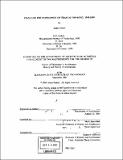CIAM and the emergence of Team 10 thinking, 1945-1959
Author(s)
Pedret, Annie
DownloadFull printable version (43.81Mb)
Alternative title
Congès Internationaux d'Architecture Moderne and the emergence of Team 10 thinking, 1945-1959
Other Contributors
Massachusetts Institute of Technology. Dept. of Architecture.
Advisor
Mark Jarzombek.
Terms of use
Metadata
Show full item recordAbstract
This study is an intellectual micro-history which examines the debates about the future of modern architecture and planning that occurred within CIAM (Congès Internationaux d'Architecture Moderne) between 1945-1959. This investigation traces the emergence of a new set of values for modern architecture as they were expressed by a group of its younger members that became known, in 1954, as Team 10. Set within the context of CIAM before World War II, the intellectual context during the war, and the radically new social and political context of Europe after the war, this inquiry pays particular attention to the period between 1954-1956, an intense period for the young Dutch and English CIAM members in developing the theoretical position that would lead to the dissolution of CIAM as an institution, form the basis of their work in Team 10's better-known period of the 1960s and 1970s, and change the terms of debate for architectural practice ever since. This inquiry contributes to the neglected area of architecture inquiry that examines theories of production. It is founded on the premise that all design production is based on a theory, implicitly held or explicitly stated, and these theories are not necessarily consistent with architectural production. From this methodological position I argue that the importance of Team 10 lies less in their role as insurgents who dismantled the institution of CIAM, than as contributors, for the discipline of architecture, to a cultural critique of Modernism occurring in postwar society in general. (cont.) This study contributes to on going studies on the development of modernist practices by proposing a critical role for Team 10 in the shift from formal Modernism to critical Postmodernism, and provides a case study for how important intellectual shifts occur.
Description
Thesis (Ph.D.)--Massachusetts Institute of Technology, Dept. of Architecture, 2001. Includes bibliographical references (p. 247-271).
Date issued
2001Department
Massachusetts Institute of Technology. Department of ArchitecturePublisher
Massachusetts Institute of Technology
Keywords
Architecture.